Study on the Increase of the Supporting Capacity of a Cement Milk Pile with Expansive Additives
Abstract
:1. Introduction
2. Materials and Methods
2.1. Experiment Outline
2.2. Experiment Method
2.2.1. Segregation Resistance
2.2.2. Compressive Strength
2.2.3. Frictional Resistance
2.2.4. Scanning Electron Microscope Image and Porosity
3. Results and Discussion
3.1. Segregation Resistance
3.2. Compressive Strength
3.3. Frictional Resistance
3.4. Scanning Electron Microscope Image and Porosity
3.5. Economic Feasibility
4. Conclusions
- Measuring segregation resistance showed an insignificant difference in settlement amounts due to expansive additive mixing when a 15% concentration was used. The change in the surplus water was also insignificant, showing no specific material separation tendency.
- Compressive strength increased with age but decreased after expansive additive mixing in all specimens, except those with W/B of 70% and 5% expansive additive. However, usability was not an issue as all test specimens exceeded the standard strength of 0.5 N/mm2 for filling material. It is also expected that the strength will increase under constraint conditions created in actual construction conditions.
- Frictional resistance increased as up to a 10% expansive additive was mixed in but decreased at 15%. Specimens containing 10% expansive additive showed stable ductile behavior during settling and a tendency to plastically deform.
- SEM image and porosity analysis revealed that as the age increased, monosulfate and C–S–H gels were densely composed, porosity decreased, and the specific surface area of pores increased, resulting in large numbers of small-scale pores. This trend increased with the mixing of an expansive additive, showing a denser microstructure.
- Regarding economic feasibility, the number of required piles was reduced as the expansive additive was mixed into W/B of 83% specimens at ratios up to 10% when the greatest frictional resistance increase was achieved. Specifically, a 10% expansive additive ratio reduced the number of required piles by up to 34.84%, providing the greatest economic feasibility by reducing the total construction cost by as much as 33.24%.
Author Contributions
Funding
Institutional Review Board Statement
Informed Consent Statement
Data Availability Statement
Conflicts of Interest
References
- Lizi, Z.; Chen, Q.; Wang, L.; Zeng, Z.; Gu, D. Numerical simulation and analysis of the pile underpinning technology used in shield tunnel crossings on bridge pile foundations. Undergr. Space 2021, 6, 396–408. [Google Scholar] [CrossRef]
- Zahraa, A.K.; Mohamed, G.A.; Adel, D. Analysis of the arching phenomenon of bored piles in sand. Alex. Eng. J. 2016, 55, 2639–2645. [Google Scholar] [CrossRef]
- Fall, M.; Gao, Z.; Ndiaye, B.C. Driven pile effects on nearby cylindrical and semi-tapered pile in sandy clay. Appl. Sci. 2021, 11, 2919. [Google Scholar] [CrossRef]
- Park, J.B. Strength and friction behavior of cement paste poured in the bored pile. J. Korean Geoenviron. Soc. 2004, 5, 31–39. [Google Scholar]
- Prayogo, D.; Susanto, Y.T.T. Optimizing the prediction accuracy of friction capacity of driven piles in cohesive soil using a novel self-tuning least squares support vector machine. Adv. Civ. Eng. 2018, 2018, 6490169. [Google Scholar] [CrossRef] [Green Version]
- Singh, G.; Walia, B. Performance evaluation of nature-inspired algorithms for the design of bored pile foundation by artificial neural networks. Neural Comput. Appl. 2017, 28, 289–298. [Google Scholar] [CrossRef]
- Luan, S.; Wang, F.; Wang, T.; Lu, Z.; Shui, W. Characteristics of gravelly granite residual soil in bored pile design: An in situ test in Shenzhen. Adv. Mater. Sci. Eng. 2018, 2018, 7598154. [Google Scholar] [CrossRef] [Green Version]
- Jung, K.J.; Kim, D.H.; Lee, C.J.; Jeong, S.S. Analysis of skin friction behavior in prebored and precast piles based on field loading test. J. Korean Geotech. Soc. 2017, 33, 31–38. [Google Scholar] [CrossRef]
- Al-Recaby, M. Assessing the increase in bearing capacity of bored piles in sandy soil using expansive additives. Kufa. J. Eng. 2019, 10, 12–28. [Google Scholar] [CrossRef]
- Jung, K.J. A strategy for developing load resistance factor design method of prebored and precast piles. Korean Soc. Civil Eng. Conv. 2016, 2016, 53–54. [Google Scholar]
- Do, J.N.; Nam, M.S.; Shim, J.W.; Park, Y.H.; Lee, S.J. Engineering characteristics of cement milk for bored piles. J. Korean Geotech. Soc. 2015, 31, 29–43. [Google Scholar] [CrossRef] [Green Version]
- Kim, S.H.; Jung, G.J.; Jeong, S.S.; Jeon, Y.J.; Kim, J.S.; Lee, C.J. A study on the behaviour of prebored and precast steel pipe piles from full-scale field tests and class-A and C1 type numerical analyses. J. Korean Geo. Env. Soc. 2017, 18, 37–47. [Google Scholar] [CrossRef]
- Choi, Y.K.; Lee, W.J.; Lee, C.U.; Kwon, O.K. Study (I) on development of charts and formulae predicting allowable axial bearing capacity for prebored PHC pile socketed into weathered rock through sandy soil layer (an analysis of sharing ratio of skin friction to total bearing capacity (SRF) by analyzing pile load test data). J. Korean Geotech. Soc. 2019, 35, 17–30. [Google Scholar] [CrossRef]
- Kim, K.W.; Chae, J.G.; Han, B.K. Applicability of solidified soil as a filling materials of bored pile. J. Korean Geosynth. Soc. 2012, 11, 37–42. [Google Scholar] [CrossRef]
- Ko, H.B.; Lee, H.S. Experimental study of file filling meterial with A thickener. Proc. Korean Inst. Build. Constr. Conf. 2020, 20, 21–22. [Google Scholar]
- Choi, H.G.; Lim, M.K.; Kitagaki, R.; Noguchi, T.; Kim, G.Y. Restrained shrinkage behavior of expansive mortar at early ages. Constr. Build. Mater. 2015, 84, 468–476. [Google Scholar] [CrossRef]
- Treesuwan, S.; Maleesee, K. Effects of shrinkage reducing agent and expansive additive on mortar properties. Adv. Mater. Sci. Eng. 2017, 2017, 8917957. [Google Scholar] [CrossRef] [Green Version]
- Qian, X.; Jiang, L.; Song, Z.; Chu, H.; Yan, X.; Zhang, Y. Impact of elevated curing temperature on mechanical properties and microstructure of MgO-based expansive additive cement mortars. Struct. Concr. 2020, 21, 1082–1092. [Google Scholar] [CrossRef]
- Park, M.S.; Kim, H.S.; Park, C.Y.; Kang, B.H. The strength property with restrained effects of the expansive mortar. J. Korea Inst. Build. Constr. 2006, 53–56. [Google Scholar]
- Lee, S.W.; Kim, N.H. Usage of CSA expansive additives for the concrete. Mag. Korea Concr. Inst. 1996, 8, 59–66. [Google Scholar]
- Gao, X.; Liu, C.; Shui, Z.; Yu, R. Effects of expansive additives on the shrinkage behavior of coal gangue based alkali activated materials. Crystals 2021, 11, 816. [Google Scholar] [CrossRef]
- Han, C.G.; Bahn, H.Y.; Jun, B.C.; Shin, E.G. A study on the properties of concrete with the addition ratio of expansive additives. JAIK 1998, 14, 349–354. [Google Scholar]
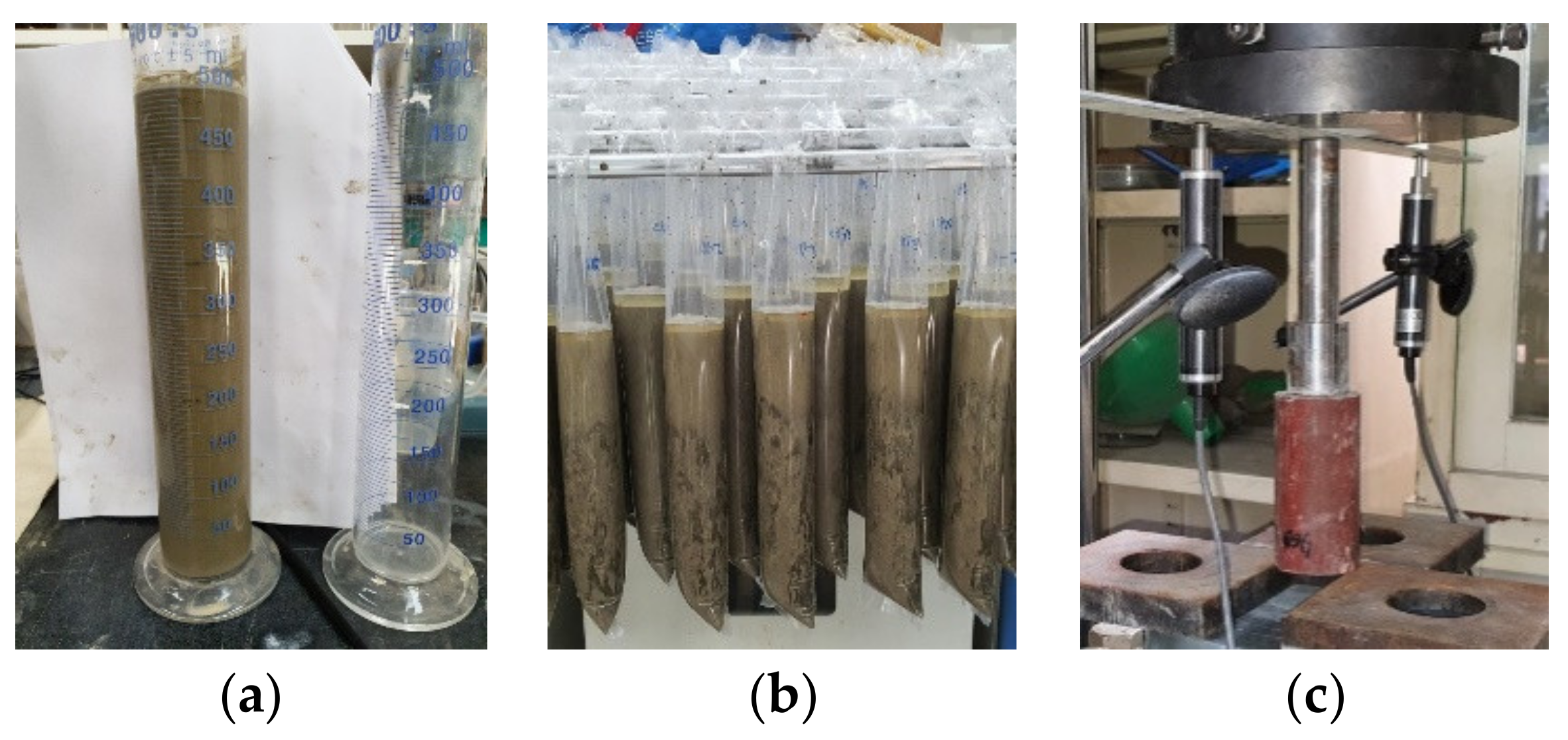
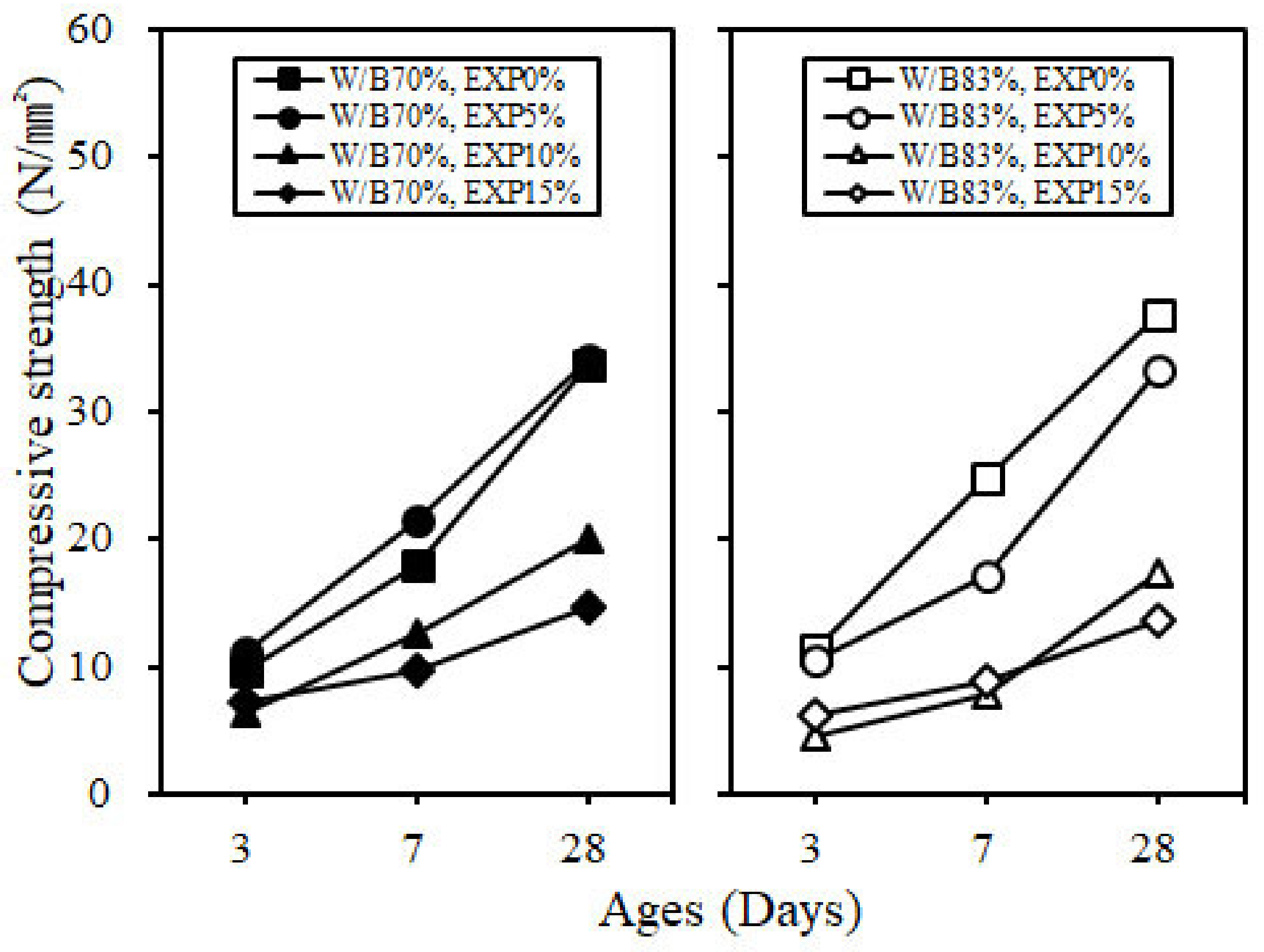



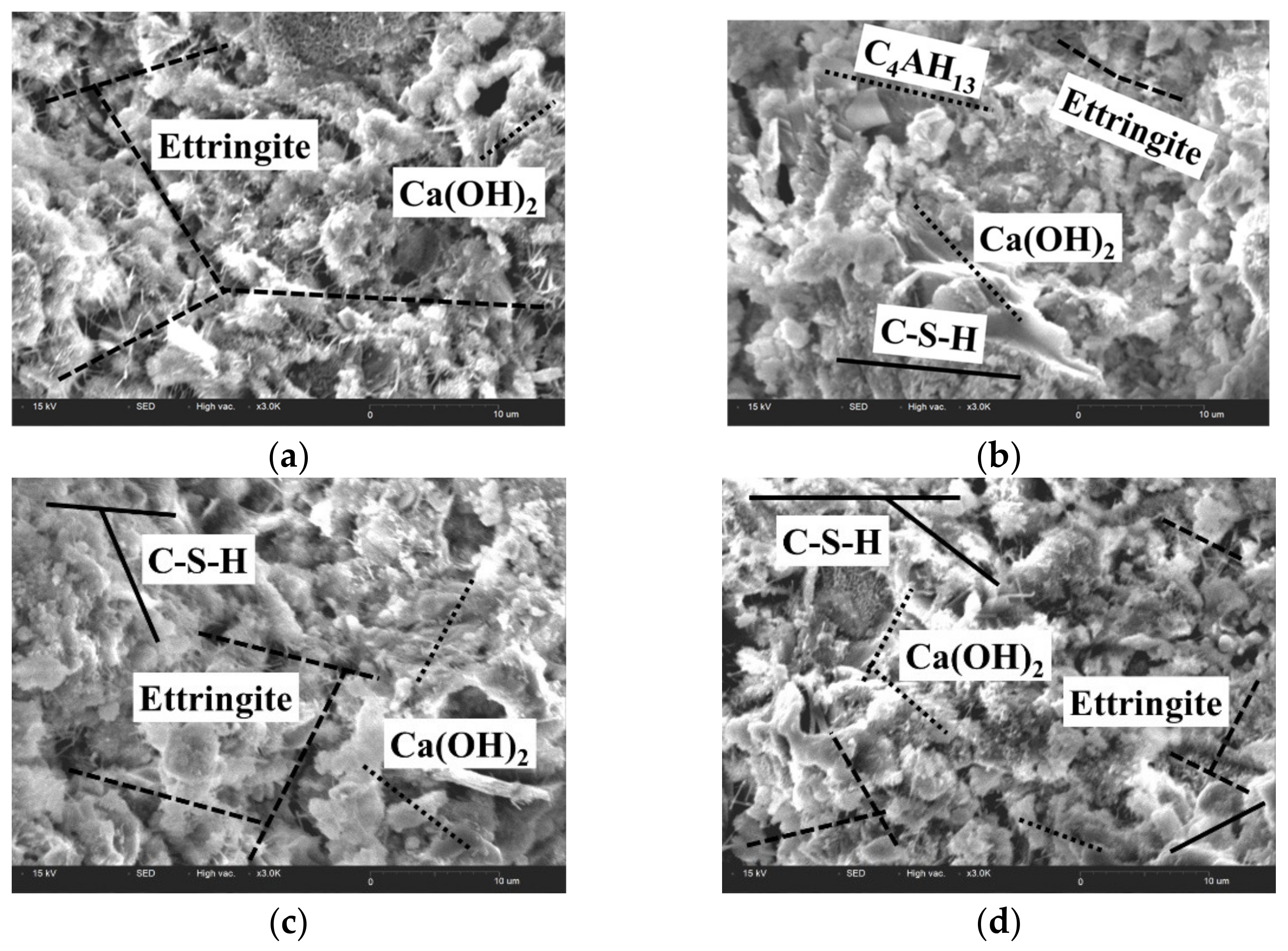
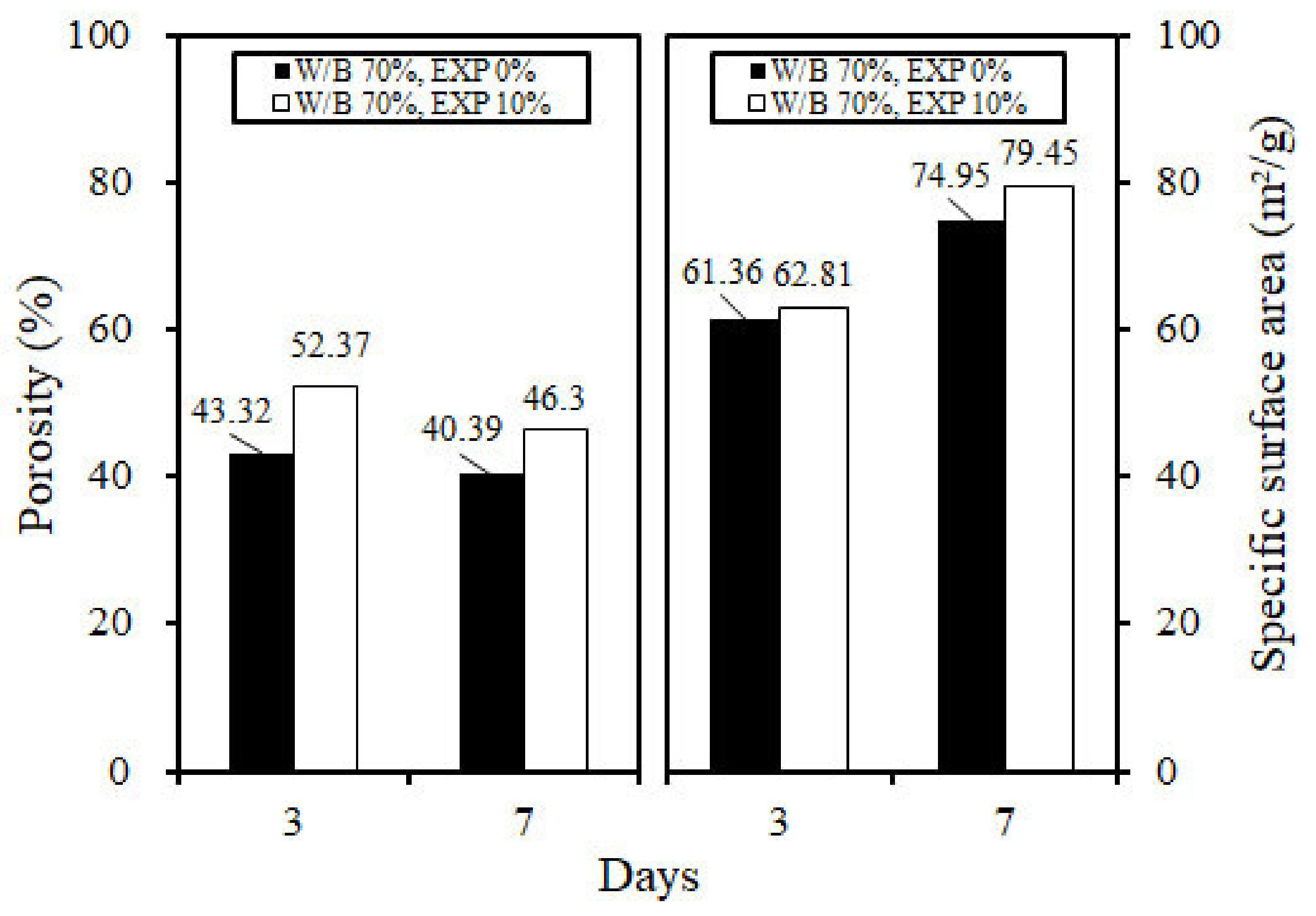
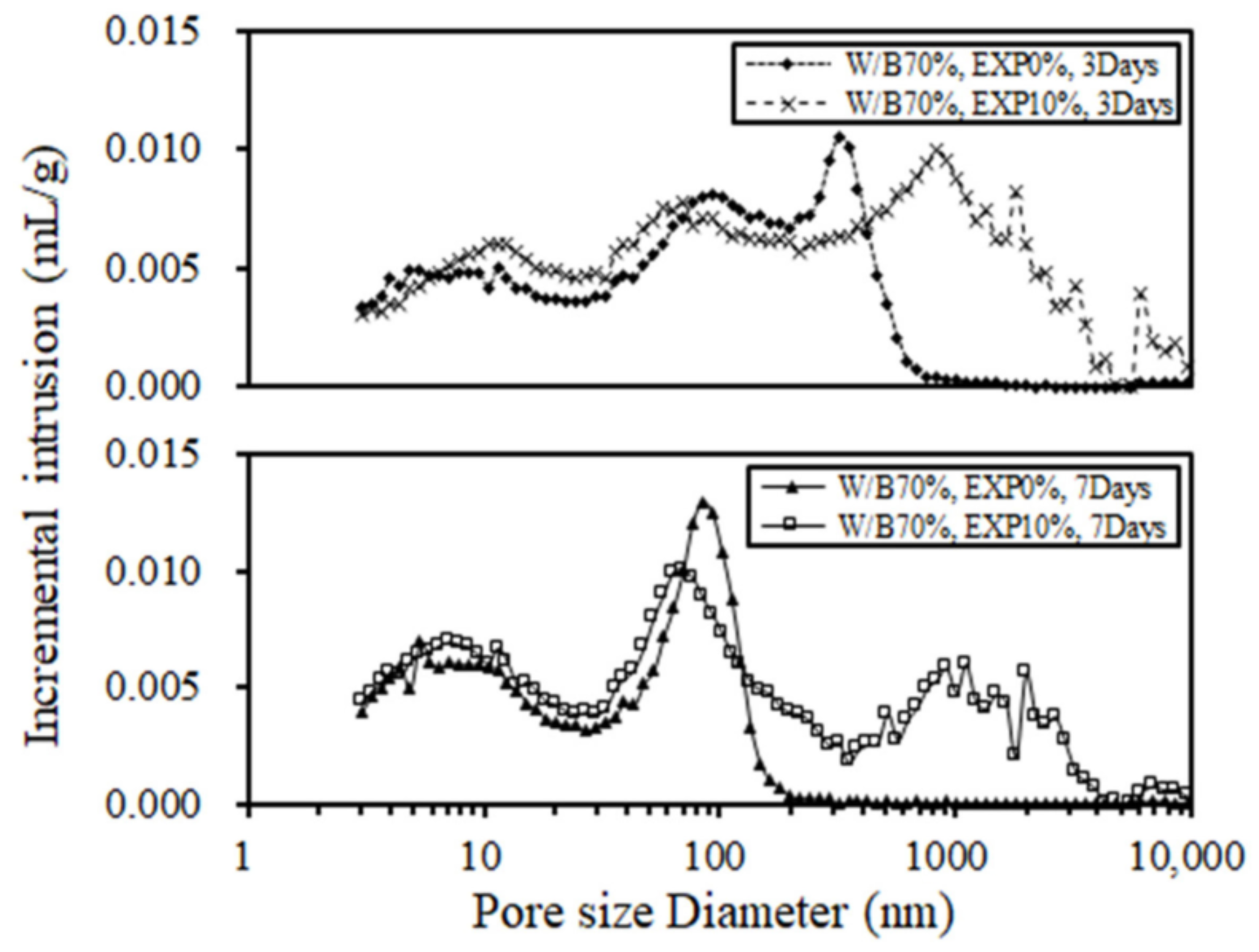

| W/B (%) | Ex (B × wt%) | Unit Weight (g/ℓ) | Evaluation Items | ||
|---|---|---|---|---|---|
| Binder | Water | ||||
| C 1 | Ex 1 | ||||
| 70 | 0 | 980 | 0 | 690 | - Segregation resistance - Compressive strength - Frictional resistance stress - SEM 1 and porosity - Economic evaluation |
| 5 | 931 | 49 | |||
| 10 | 882 | 98 | |||
| 15 | 833 | 147 | |||
| 83 | 0 | 880 | 0 | 730 | |
| 5 | 836 | 44 | |||
| 10 | 792 | 88 | |||
| 15 | 748 | 132 | |||
| Type | |
|---|---|
| Cement | Ordinary Portland cement (KS L 5201) |
| Density: 3.12 g/cm3 | |
| Expansive additive | CSA expansive additive (Type of calcium sulfoaluminate) |
| Density: 3.15 g/cm3 | |
| Water | Water supply |
| Type | 0 h | Time 3 h | 24 h | 672 h (28 days) |
|---|---|---|---|---|
| W/B (83%) EXP (0%) | 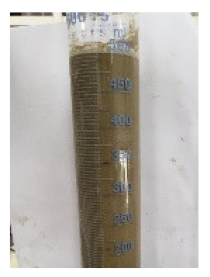 | 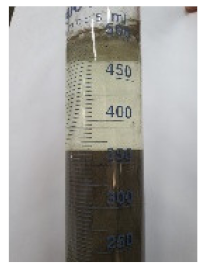 | 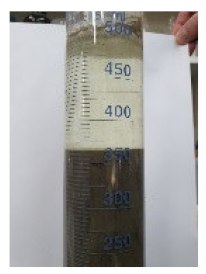 |  |
| Settlement (mL) | 0 | 135 | 135 | 135 |
| W/B (83%) EXP (15%) | 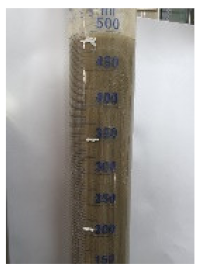 | 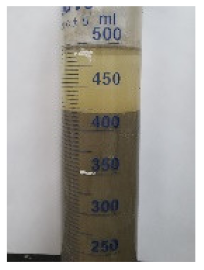 | 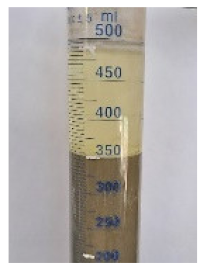 |  |
| Settlement (mL) | 0 | 80 | 150 | 150 |
Publisher’s Note: MDPI stays neutral with regard to jurisdictional claims in published maps and institutional affiliations. |
© 2021 by the authors. Licensee MDPI, Basel, Switzerland. This article is an open access article distributed under the terms and conditions of the Creative Commons Attribution (CC BY) license (https://creativecommons.org/licenses/by/4.0/).
Share and Cite
Choi, H.; Lee, T.; Choi, H.; Lee, K.; Lee, D.-E. Study on the Increase of the Supporting Capacity of a Cement Milk Pile with Expansive Additives. Appl. Sci. 2021, 11, 9922. https://doi.org/10.3390/app11219922
Choi H, Lee T, Choi H, Lee K, Lee D-E. Study on the Increase of the Supporting Capacity of a Cement Milk Pile with Expansive Additives. Applied Sciences. 2021; 11(21):9922. https://doi.org/10.3390/app11219922
Chicago/Turabian StyleChoi, Hyeonggil, Taegyu Lee, Heesup Choi, Kangsoo Lee, and Dong-Eun Lee. 2021. "Study on the Increase of the Supporting Capacity of a Cement Milk Pile with Expansive Additives" Applied Sciences 11, no. 21: 9922. https://doi.org/10.3390/app11219922
APA StyleChoi, H., Lee, T., Choi, H., Lee, K., & Lee, D.-E. (2021). Study on the Increase of the Supporting Capacity of a Cement Milk Pile with Expansive Additives. Applied Sciences, 11(21), 9922. https://doi.org/10.3390/app11219922








